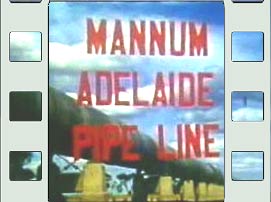
Irrigation and Exploitation: Piping the water away
World War Two hastened the need for industrial development and the post-war period emphasised Australia's need to adopt newer methods to achieve growth. As South Australia developed and the population increased, reliable water supplies became a major concern. The available sites for reservoirs holding surface run-off had already been exploited and it became clear that the River Murray would be the most significant means to increase water supply to settled areas for the future.
Under the impetus of Sir Thomas Playford, the new industrial town of Whyalla was one of the first areas to receive water piped from the Murray when the Morgan-Whyalla pipeline was completed in 1944. The water allowed for increased primary production in the region and enabled Broken Hill Proprietary to expand steelmaking and shipbuilding in Whyalla. This pipeline was duplicated in the early 1960s to meet increasing demand.
It soon became apparent that Whyalla might compete with Adelaide's potential for industrial development and planners realised the need to address Adelaide's water requirements.
Construction began on the Mannum-Adelaide Pipeline in 1951 and by 1954 the line was supplying water to Adelaide.
Since then three other pipelines have been constructed to supply water around South Australia. The Swan Reach to Stockwell pipeline, which services the lower north and Yorke Peninsula, and the Tailem Bend to Keith pipeline, servicing townships and farms in the Coonalpyn Downs area, were built in the late 1960s. The pipeline from Murray Bridge to the Onkaparinga River near Hahndorf was constructed between 1967 and 1973.
These pipelines have become vital to agriculture, industry and households throughout South Australia and in dry years can supply up to 85 per cent of the state's urban water needs. Other areas of the state rely on bore water from underground basins, or natural springs.
The questionable flavour and odour of Adelaide's water has attracted criticism and has resulted in the installation of filtration plants. The quality is affected by problems such as low flows and salinity which are in part the result of taking too much water from the river upstream. Fears of a dwindling supply have generated the need for government intervention in the form of unprecedented water restrictions that control the times and delivery methods of mains water. In October 2003 SA Water announced that the water restrictions implemented in July 2003 would become Permanent Water Conservation Measures for South Australia. The terms of the restrictions can be viewed at the SA Water website [See: Environment: Water Restrictions & Permanent Measures].
Items 1 - 9 of 9











